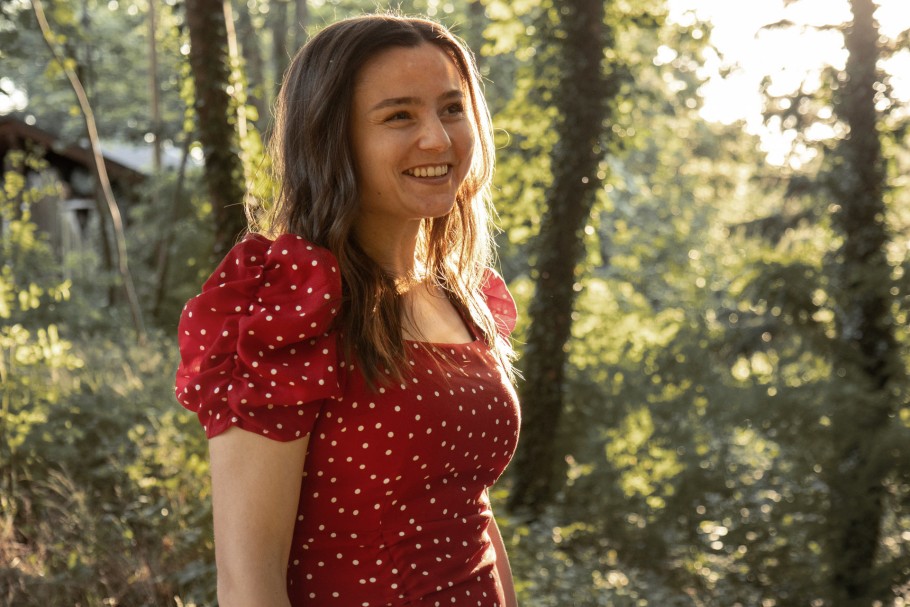Everyday life of a consultant at the Cluj location
Henrietta reports
Henrietta has been working as a consultant and project manager for the agile development of complex websites with TYPO3 at the Romanian location in Cluj since 2017. When she joined the Cluj team after graduating in Business Administration from the Babes-Bolyai University in Cluj and gaining her first professional experience in customer service at a German company, she didn't know exactly what she was getting into with Scrum, because agile project management was not yet very well known in 2017. Today, she raves about her Scrum projects, as after a week of sprinting, both the customer and the development team are happy to have a tangible result in their hands.
A certification as Scrum Master in 2019 laid the foundation. Since then, the eloquent and empathetic consultant & project manager - and since the beginning of 2023, head of the Scrum team - has developed into an absolute expert in Scrum processes and is happy to pass on her knowledge.
We talked to Heni about how she structures her everyday life, which mainly takes place in her home office, what challenges she masters with her clients and what criteria have to be met for a project to become her favorite project.

(1) How does a typical working day start for you?
My day always starts with a cup of coffee and a positive thought! Sometimes I also use a positive thought generator – that's a bit clichéd from time to time, but mostly something really nice comes along to set you up positively for the day.
After logging in, the first thing I do is check my email and Slack messages. After that, at 9:45 a.m., we go to the first daily for a team meeting and, if necessary, at 10 a.m. to the second daily, especially with the support team.
(2) How do you structure your working day?
There are two different scenarios. There are days when the focus is on ongoing customer service or it is on the preparation of future projects. And there are sprint phases in which I, as Scrum Master, meticulously plan a whole week.
Regular customer support
Support means that websites that have already been implemented are continuously developed, maintained and updated for our customers. Or that emergency measures must be taken. Or that individual features need to be revised or fixed.
Basically, in that case I have regular calls with the customers – including many long-standing customers.
As a rule, the customer communicates his requirements to us via our ticket system Jira. That's why one of my daily tasks is to keep an eye on Jira in order to take over the initial qualification of tickets. I often work out the tickets in more detail and supplement them with additional information and examples. Many customers also contact us by phone or e-mail. Then I create the ticket myself. In any case, I do my best so that the developer can quickly grasp and solve the task. If necessary, I also consult with the customer to answer developer questions and occasionally conduct research.
Before I set a ticket to done, I test and check the result according to the four-eyes principle before it is handed over to the customer.
Quarterly and annual planning with customers
At regular intervals I meet with the customers in jour fixes. We then make a joint analysis of the hours already defined and worked within the framework of a support contract and discuss what potential for improvement there is. We get feedback from the customer on what went well or not so well and discuss the customer's concerns, for example about an upcoming TYPO3 upgrade or the introduction of a new newsletter tool.
Sometimes the team at the customer's end is working intensively on some topics. Then it is important to understand them and plan accordingly at our end. Following the discussion, I log them on Confluence and integrate these topics into our plannings for the next annual or quarterly period(s).
Preparation of new projects
When preparing for new projects, processes must be created in the agency software Barbuda, permissions must be assigned or adapted in Confluence/Jira, and folder structures must be created in the file system. At the end of the month, I take care of billing and determine and release project hours or days that have been accrued.
Exciting sprint weeks
Sprint weeks are my favorite weeks. These are always well-planned, intensive and highly dynamical weeks. And in the end, there is a tangible result that makes everyone happy.
The structuring of a sprint week is quite different from that of a week in support.
What do you find exciting about sprints?
I like everything that's well organized, and sprint weeks are like that:
On Monday, we start with a backlog refinement, where the sprint backlog will be created. On the customer side, a product owner or an experienced employee from editorial or marketing is involved. We also have an agency-side product owner as a consultant, but the final decision on prioritization is of course up to the customer. The planning focuses on the tasks that can be implemented within a week of production.
Then we hold sprint dailies every day to identify and remove obstacles.
At the end of the week, my favorite sprint ceremonies take place: the sprint review and the retrospective. It's always a great feeling when the increment (partial product) is presented at the end of the sprint and we see how enthusiastic the customer is. Within the retrospective, we discuss what went well or not so well. And we are collecting ideas on how we can make the upcoming sprint even better.
I find it exciting when we create something completely new. With feature developments or upgrades you can see the results after just one week! In any case, I think it's very nice that a result can be published after just one week of intensive work on a product. Just recently, we created a world map for the University of Erfurt, which makes it possible to filter by research projects.

If you follow this big-picture principle, then it's fantastic to see that you create little components for a website piece by piece and that every piece of the puzzle goes into its right place so that the website works out great in the end.
And it's great to see how enthusiastic the customer is at the presentation.
A customer who was involved from the very beginning, who was present at the backlog refinement meetings and in the plannings, where we were able to clarify questions together and made estimates, is always very impressed when he sees what we have achieved at the end of the week. And when we did less than we thought, he saw first-hand in the dailies why it was more complicated than expected. He feels part of the team - because he has tested, approved progress and given feedback. For me, that's what makes Scrum so great, so sometimes I forget that we're service providers. I actually have the impression that we all belong to the same team.
Ein Kunde der von Anfang an involviert wurde, der bei den Backlog-Refinement-Terminen und in den Plannings dabei war, wo wir zusammen Fragen klären konnten und Schätzungen gemacht haben, ist immer sehr angetan, wenn er Ende der Woche sieht, was wir geschafft haben. Und wenn wir einmal weniger geschafft haben als gedacht, dann hat er in den Dailys hautnah mitbekommen, warum es komplizierter war als gedacht. Er fühlt sich dabei als Teil des Teams - denn er hat getestet, Fortschritte freigegeben und Feedback gegeben. Für mich macht das Scrum so großartig, so dass ich manchmal vergesse, dass wir nur Dienstleister sind. Ich habe dann tatsächlich den Eindruck, dass wir alle zum selben Team gehören.
(3) What are your favorite projects?
All university projects are close to my heart. On the one hand because I am well versed in the subject matter, on the other hand because I have been working with a constant team in these projects for years. It's just fun, even if university projects are often very intensive and exhausting due to their density of detail.
Accessibility requirements also play a major role for universities and institutional customers. Today, we pay much more attention than in the past to not only meeting the standards. Rather, our goal is to really help people.
Customer relationship at eye level
One of my favorite projects is PARI's website. PARI has been our customer for 12 years. Our common goal is to continuously improve the website. This is sometimes an exciting challenge in the context of budget requirements and marketing goals, which I think we have always solved very well. The cooperation with the customer is always absolutely solution-oriented and the interaction is respectful. This customer relationship at eye level is exctremely satisfactory!
(5) How are the teams structured? Who works in the teams?
People of different nationalities, ages and genders. We have a great working relationship.
(6) What do you do to meet in a team outside of work?
Most of the time we do something together once a month. When we meet in the office to discuss something, we always go out to eat together.
In addition, we also go hiking or bowling. Some of the colleagues meet for video game evenings or for our online game night "On the Rocks", where the German and Romanian colleagues participate.
And then there are team events with the Munich/Cluj team. Or colleagues meet at the TYPO3 camps.
What do you do to meet up as a team outside of work?
We usually do something together once a month. When we meet in the office to discuss something, we always go out for a meal together.
We also go hiking or bowling. Some of our colleagues meet up for video game evenings or for our online games evening "on the rocks", where our German and Romanian colleagues take part.
And then there are team events with the Munich/Cluj team. Or colleagues meet up at the TYPO3 camps.
Many thanks, Heni, for these interesting, personal insights.